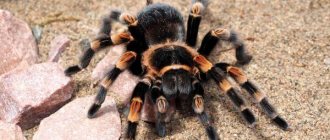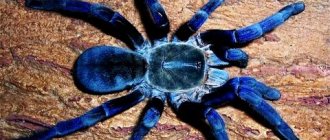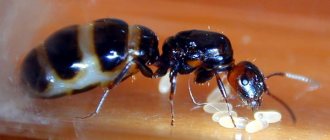A spider as a pet is much less common than the usual cats or dogs. At home, the tarantula spider is usually found only among spider breeders or ardent lovers of exotics.
When planning to get a spider, you need to carefully study the natural conditions familiar to a particular species in order to subsequently try to create a comfortable microclimate for the pet.
In addition, it is important to choose a terrarium (spider cage) of a suitable size and organize proper nutrition.
Rules for keeping tarantula spiders at home
As mentioned above, spiders are found in regions with hot climates. This must be taken into account when keeping individuals at home. Among the most important points to pay attention to when placing an animal are the following:
- The pet must move freely around its home, so it needs to choose a spacious container.
- Tarantula spiders love warmth, but bright sunlight harms them. Place your pet in a warm and dark place in the house, and do not forget about the humidity of the room.
- It is necessary to monitor the behavior of individuals; outbreaks of aggression between young and adult pets often occur. Throughout life, there are several key moments, which include periods of reproduction and the emergence of the younger generation. To avoid cannibalism, adult pets should be transplanted from young animals in a timely manner.
- The animal often sheds and pollutes its home; it is necessary to periodically clean the terrarium, as well as change the soil to maintain optimal living conditions.
What should a spider's home be like?
Animals may experience stress when moving from their natural habitat, so choosing a new home is key when it comes to pet placement. When choosing a habitat, pay attention to the following parameters:
- A terrarium or aquarium is perfect for creating an artificial habitat, and there should be enough space for your pet. It is necessary to take into account the size of the individual and take a terrarium with a wall that is twice the length of the animal’s body.
- For underground species, soil at the bottom of the container is suitable; its thickness should be at least 5 cm, and soft and hard layers of soil can be combined. For those individuals that lead a terrestrial lifestyle, you will have to additionally install a snag or a small log in the aquarium. Spiders will crawl along this snag and also weave webs on it.
- An equally important issue is maintaining climatic conditions. The pet's habitat should be warm, the temperature should not be lower than 25 °C. But at the same time, it is better to hide the aquarium from direct exposure to sunlight.
Nutrition
The tarantula spider at home feeds on beetles, cockroaches, earthworms and beetle larvae. Feeding insects are specially grown to feed arthropods. Young animals are given zofobas or darkling beetle larvae; They are popularly called mealworms.
The length of the larva should correspond to 1/3 of the size of the abdomen. If after feeding it does not increase in size, then the individuals are given more food. A sign that the tarantula has eaten is an enlarged abdomen. After molting, adult spiders are given the same soft food as young ones.
At home, the tarantula is fed with darkling beetle, zofobas, Madagascar, Argentine, and Turkmen cockroaches. He can catch a cricket, a grasshopper, a locust, a small lizard. Animals love to hunt them. Insects are placed in a terrarium alive. The remaining feed is removed so that it does not rot.
Care for tarantula spiders is minimal. It is important for them to provide warmth, moist air and soil, and good ventilation. Feeding is carried out once a week. The young are given food every 3 days.
It is recommended to clean the bedding from feces and food residues. To do this, the tarantula is moved to another container. The soil is heated in a frying pan. You must handle the animal with great care.
Cleaning and cleaning, hygiene
Correct and high-quality soil poured into the terrarium is very important . Good soil helps maintain optimal moisture levels. You can choose the soil yourself quite easily. Such a substrate must have good air permeability. Among other things, the soil must be as clean as possible to prevent the development of putrefactive microflora and mold. The optimal substrate is one with sufficient moisture content, but not too fine.
To make the substrate sufficiently moist, it is necessary to regularly wet the soil with clean water at room temperature. Excessive waterlogging and insufficient soil moisture inside the terrarium are unacceptable, and often become the main cause of death or death of a pet. Hygienic cleaning of the walls and bottom of the terrarium should be carried out as it gets dirty. It is also possible to partially replace the substrate.
This is interesting! Experienced owners of tarantula spiders recommend adding coconut substrate to the bottom of the terrarium, which has all the characteristics necessary for keeping arthropods at home.
Description of the species
The Latin name for the tarantula Irminia is psalmopoeus irminia. It was first found on the South American continent, in Venezuela. The individual was found under the bark of a tree. Arachnologists define the spider's range as the northwestern territory of South America. The animals live in Venezuela, Guyana, an island part of the Atlantic Ocean. The tarantula was described in 1994.
The main color of psalmopoeus irminia is dark. The abdomen is brick-colored. Along the center there is a wide black stripe. It is crossed by horizontal stripes. Orange color is noted on the limbs. Vertical stripes are noted on 2-3 phalanges. The hair pads at the ends of the paws are black. The tarantula's back is dark, but a pattern can be discerned on it. It is decorated with orange and red splashes.
- A medium-sized spider: body length 6 cm, paw span 15 cm. It is a long-livers. The female can live up to 15 years. It reaches a large body size at 10 years of age. Young individuals molt frequently, once every 2 weeks. Their rapid growth occurs until puberty. During puberty, their reproductive organs develop. After this, the spiders are considered adults. Their growth is slowing down. Shedding occurs once a month. Then, once every 6 months. Mature tarantulas shed their exoskeleton once a year.
- The tarantula Irminia reaches adulthood at 8 months. Females develop closer to 2 years. Some keepers, when keeping spiders at home, specifically inhibit the growth of males. To do this, they lower the temperature and reduce the protein diet of individuals.
- The female begins to build a cocoon 2 months after fertilization. A clutch can contain 500 eggs. To ensure that they are distributed evenly throughout the cocoon, the female turns it over with her limbs. She does not leave him without attention, does not leave the nest, even when severely exhausted.
- Nymphs appear after 2.5 months. You don't need to feed them. They feed on leftover egg yolks. After 3 molts, they develop into larvae that look like small spiders. They are fed maggots and zophobas beetle larvae; the size of the larvae can reach 6 cm; spiders are given ¼ part.
- The Irminia tarantula withstands temperature changes well. Some species live in the mountains, at an altitude of 600 m above sea level. A comfortable temperature for them is 19-22 0C. Individuals that prefer tropical forests are accustomed to higher temperatures, 26-28 0C.
- Animals are sensitive to air humidity of 80%.
Loading …
The venom of spiders is highly toxic, but individuals are not aggressive. They release poison only during hunting or when they sense danger. The main natural enemies of tarantulas are larger vertebrates. Aga toads can climb into the burrows of young animals and eat spiders and eggs of arthropods.
The keeper's hand in the terrarium can cause stress in the animal. At the slightest change in the spider’s behavior, the hand must be removed. Otherwise, the individual will attack and bite.
Reproduction
The sex of a tarantula spider is easy to determine if you follow the recommendations of experts. Young spiders begin to molt after about a month. After molting, the skin is taken and carefully examined. In the posterior region of females there is a depression, and in males there are something like two tubercles. If the individuals are adults, then the sex can be determined by appearance. Males have slightly slimmer legs and are taller, while the body is significantly smaller in size than the female.
After mating, the eggs develop inside the female for 2 months. During this period, she must form a special cocoon. At one time, she can lay up to 500 eggs, while about 50 spiders remain alive. In order for the juveniles to actively develop, the cocoon is moved to a separate terrarium, thereby creating certain temperature conditions.
For the first month, baby spiders do not eat anything, until the first molt. Until this moment, they can be together, after which they are separated one by one. A female tarantula spider molts up to 12 times during her entire life. Males stop moulting immediately after puberty.
Interesting to know ! The tarantula spider is constantly growing and maturing, which is why it needs to shed its “old clothes”. Before molting, individuals turn over on their backs, trying to remove their old skin. At the same time, he completely stops eating. After molting, the spider gets a new color, and the pile is completely renewed.
Danger to humans
Before you get such an undemanding pet at home, you should find out how poisonous it is. It must be remembered that although this type of spider can bite a person, these bites do not pose a danger.
The animal can bite if it feels its life is threatened, but before that it can rise on its hind legs and create menacing hissing sounds. The tarantula spider bites with chelicerae, at the end of which there are fangs, the length of which is about 2 cm. During the bite, it injects poison.
The bite site becomes inflamed, followed by swelling and swelling. All this is accompanied by pain. After about a week, the negative consequences of the bite disappear. This is especially true for people prone to allergies, as well as those with weakened immune systems. After a bite, such people experience a deterioration in their general health and severe weakness, with nausea, diarrhea, dizziness and headache.
Spiders cannot be trained in any way, so a person must study their behavior patterns. If the spider has poisonous hair, then it is better to handle it while wearing gloves, otherwise it may irritate the skin.
It is important to know! There is a category of people suffering from arachnophobia - fear of spiders. If such a person accidentally and unexpectedly encounters a tarantula spider, he may die of fear. In this regard, it is necessary to ensure that the animal is not able to leave the terrarium and does not start traveling around a person’s home, or even worse, among its neighbors.
Advantages and disadvantages of keeping a spider
Many people keep spiders for the purpose of shocking. Like, look at the scarecrow that lives with me, is it impressive? But such people are in the minority. There are, of course, individuals who are obsessed with spiders, who admire their habits and opportunistic features. But, basically, spiders are owned by those who consider them to be very beautiful pets.
And from this judgment follows the main, in my opinion, advantage of spiders - their appearance. Now you can buy spiders of a wide variety of colors, there are pink, red, pitch black and even bright blue. These are incredibly beautiful animals that are a pleasure to look at.
This type of spider has very interesting, curled hairs.
The main reason why I got myself a spider is its unpretentiousness. Such a pet can be left for a week or more with a clear conscience. If you need to go somewhere, then rest assured that the spider will wait for you and will not die of hunger, since it can go without food for a very long time.
This is an ideal option if you have a small living space. It does not take up much space and does not create noise. If you remove leftover food, there will be no unpleasant smell either. He doesn't shed his fur in the usual sense and you don't need to walk with him - a miracle, not a pet.
One of the main disadvantages is that spiders are quite secretive people. Most likely, your pet will hide in a shelter most of the time.
You can't pet a spider in the usual sense of the word. Even picking him up is not recommended, as this is very stressful for the animal.
A particular disadvantage is the presence of food animals in your home. For example, if you decide to keep a colony of cockroaches yourself, then you won’t leave them for a month.
Well, despite their terrifying appearance, spiders are quite fragile. Even a fall from several tens of centimeters threatens the spider with death. The animals are quite nervous. Factors such as transportation, changing the terrarium, and an abundance of insects can cause stress. Spider stress is bad. The pet may comb its hairs, refuse to feed and, in especially severe cases, even die.
It doesn’t bark, doesn’t bite, doesn’t rush at passers-by... Just kidding, of course, a spider can bite, it has everything for that. But such cases are extremely rare. Of course, the venom of all tarantulas is toxic to one degree or another. But an adult should not have any serious problems.
Possible difficulties
Vagans can not only be very aggressive, but also move quickly and actively, even a little nervously. Therefore, it can be quite difficult for an unaccustomed person to catch it. It is better for beginners to know about this feature and either choose a much calmer representative of the genus as their pet, or not let the spider out of their home unless absolutely necessary and carefully monitor it.
A tangible advantage is that the tarantula’s venom is not dangerous to humans, and even if bitten, nothing terrible will happen. The sensations will be similar to the consequences of a bee sting.
The body length of an adult is 6-7 cm
However, it is still somewhat dangerous for humans. If he is frightened or angry, which happens quite often in this species, he gets into a pose expressing aggression and begins to intensively comb the hairs from the abdomen. This is not just a nervous gesture - the stinging hairs have an irritating effect, much like nettle thorns. When they come into contact with the skin, they cause severe redness and itching. This allergic reaction is not too dangerous for most people, but for some it can be very unpleasant.
Shedding
Regular replacement of the exoskeleton, which is not capable of stretching, is necessary for the growth of the tarantula and is considered a natural physiological process. The shedding period is called molting. In adults, this happens annually, and at a young age, spiders molt several times a month. The approach of molting is indicated by darkening of the color and partial loss of hairs. Often animals refuse food and lie down on their backs. It happens that when the old integument is shed, the hind legs come off, which later grow back. Important! Tarantulas do not require human assistance when getting rid of their exoskeleton and can even cause harm.
Diseases, treatment and prevention
Diseases affecting tarantulas are currently classified as insufficiently studied, so there is no established practice for their treatment. The most common cause of death for a spider living in captivity is severe dehydration, so the substrate must be constantly and sufficiently well moistened.
The tarantula may also die as a result of injury or severe bruising . To prevent your exotic home from falling from a great height, it is very important to use a cover with small but numerous ventilation holes to cover the terrarium. In order to treat the wound caused by arthropods, regular petroleum jelly is used.
Several types of mites can parasitize spiders, but the greatest danger to exotics is posed by predatory ectoparasites, which infect the lungs of the arthropod and cause a fairly rapid death of such a pet. For preventive purposes, a complete replacement of the substrate in the terrarium should be carried out every six months. Internal parasites, represented by nematodes, cause no less harm to the spider, so it is very important to keep the tarantula’s home clean.
Natural enemies
Despite their poisonous nature, tarantula spiders quite often become prey for many other animals. Predatory species of centipedes, including Scolopendra gigantea, are quite capable of coping not only with the largest tarantulas, which include Theraphosa blondi, but even with many species of not very large snakes. Another dangerous predator for the spider is a representative of the genus Ethmostigmus, which inhabits Australia and is one of the natural enemies of the tarantula.
Some vertebrates destroy arthropods, including the largest Australian frog, Litoria infrafrenata, or the white-lipped tree frog and the aga toad Bufo marinus. The body of tarantulas is often parasitized by small dipterous insects belonging to the genus Megaselia and the family Phoridae and hawk wasps. The larvae grow and develop inside the spider, causing its death.
A natural competitor for the giant Goliath tarantula is the spider Heteroroda maxima, found in Laos and superior to the Goliath solely in the span of its legs.
How long does a tarantula live in captivity?
The lifespan of different species of tarantulas when kept in captivity varies greatly. For example:
- arboreal species and tarantulas belonging to the genus Pterinochilus - no more than 7-14 years;
- all large terrestrial species - about 20 years.
Males mature earlier than females, at about a year and a half, so most often the average life expectancy of a male tarantula after the last molt does not exceed six months. However, so-called long-lived males who have lived for long periods of time are also known:
- males of Grammostola rosea – one and a half years;
- males Megarobema velvetosoma – nine months;
- males Poecilotheria formosa - about 11 months;
- males of Poecilotheria ornata – a little over a year;
- males Poecilotheria rufilata - approximately one and a half years.
A unique and rare case has been recorded in which a captive male arboreal tarantula Poecilotheria regalis was successfully able to molt a couple of times with a month and a half interval between molts
Lifespan
It is important for people who decide to keep this animal at home to know how long tarantula spiders live in captivity. Females, regardless of conditions, can live up to 30 years
As for males, their life expectancy is much shorter. They usually stop molting after reaching reproductive age, in most cases they die in the same year or after mating.
When maintaining a home, it is important to choose an arthropod suitable nutrition system and optimal temperature. If fed infrequently, the spider will live longer
Cold causes the metabolism to slow down, so the birder's development will slow down.
Precautionary measures
The most poisonous tarantula on our planet is the incredibly beautiful and bright arboreal metal tarantula (Poecilotheria metallica). This is a very strong and fast, aggressive and completely unpredictable arthropod, the distinctive feature of which is the ability to jump high.
The venom of this species is very toxic, and a bite can cause severe pain, increased heart rate, increased sweating, migraines, muscle cramps or severe weakness in humans. However, as practice shows, a fatal outcome is unlikely. Despite the fact that the woody metal tarantula spider is very rare and is listed in the International Red Book, it is sometimes found in the collections of connoisseurs of exotic arthropods.
Features of choosing a pet
In order to choose a healthy spider, you need to use a few simple tricks that will help protect yourself from wasting money:
- the arthropod must be active and playful. In the case when the specimen you have chosen lies alone on the sidelines, is passive and constantly hides in the house, the animal is most likely sick, and you should not buy such a pet for home;
- A healthy spider's abdomen should be even and smooth. If the abdomen is wrinkled or there are other pathologies on it, the spider suffers from dehydration and may soon die;
- open wounds or ulcerative defects on the body of a tarantula are another reason to refuse to purchase such a spider;
- It is best to purchase small spiderlings , since it is almost impossible to determine the age of a tarantula by appearance;
- It is important to pay attention to the hairs that cover the abdomen. If they are not evenly distributed throughout the body or vary in size, the animal has health problems;
- the absence of paws in most cases is not a pathology , since they will instantly grow back after the next molt. This only means that the animal was not transported properly.
Important! When choosing a tarantula, you need to pay attention especially to females, since males do not have longevity and live several times less.
Is it possible to pick it up?
It is not prohibited to pick up a spider; the main thing is to tame the animal so that it does not cause stress to it. When stressed, a spider may attack you and even bite you. Therefore, tarantulas need to be tamed gradually and immediately after purchase. The animal must understand that you will not harm it; to do this, you must first gently stroke it on the back. Gradually, the pet will reach out to the hand and begin to climb on it. At this time, the main thing is to ensure that your pet does not run away, since in most cases the animal will disappear without a trace.
Lighting
As mentioned earlier, lighting can negatively affect the spider's health. And the sun's rays can even kill a spider. The fact is that tarantulas are nocturnal animals and light can cause them great stress. But if you need to monitor your pet, then you can use moonlight lamps, which will create an imitation of night and cause minimal stress to the spider.
How much does a tarantula spider cost?
These exotic animals are not that cheap, as some of the species cost a lot of money. You can purchase a tarantula spider in various ways: via the Internet or through an advertisement, or by going to a pet store. Depending on the type, you will have to pay from 100 to 10 thousand rubles. Moreover, females are always more expensive.
When choosing a pet for yourself, you should pay attention to a number of factors, including age. It is better not to buy too large individuals, as they may be old. Secondly, you should pay attention to the shell. If they are damaged or have wrinkles or cracks, it is better not to take such individuals, as they may turn out to be sick. It is not recommended to buy spiders before or immediately after molting, since it is not possible to determine how active the animal is.
Reviews from tarantula owners
The tarantula spider cannot be raised, trained or tamed in the sense of such words that are familiar to owners of exotics . Even a very calm tarantula may well bite its owner if it suddenly senses danger.
This is interesting! Experienced spider keepers recommend performing all manipulations related to maintaining the terrarium using special, fairly long tweezers.
As the owners note, tarantulas, which were surrounded by attention in childhood and were often picked up, are most relaxed about their surroundings and their owner.











